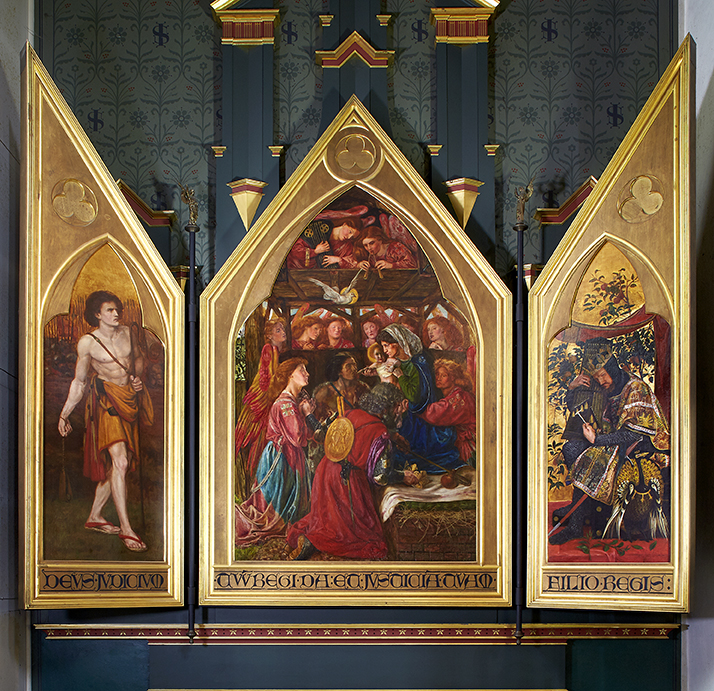
Rossetti was commissioned to do a painting for the reredos of the high altar in 1855. He was extremely slow in producing it and the whole painting was not finally delivered until 1864, much to the relief of the Dean and Chapter. Rossetti was very unhappy with its location (the light was all wrong) and its setting (white Caen stone). In the post-war restoration of the cathedral, George Pace did not wish to return to the Victorian arrangement of the sanctuary, and so the painting was moved to the newly created Illtyd Chapel under the Jasper Tower. In 1989, Donald Buttress, the Cathedral Architect, re-furbished the chapel and chose to provide the painting with a new frame with the muted richness of distressed gold leaf. Both these changes may have gone some way to meeting Rossetti’s original objections.
At first sight, the painting appears to be a straight-forward depiction of the Nativity, but Rossetti declared that he was in fact presenting “a condensed symbol of it”. He sought to show that Christ was descended from rich and poor. He did this by emphasising Christ as the ultimate descendant of David, who is shown in the side panels as both poor shepherd boy and wealthy king. He also wanted to show that Christ was worshipped by rich and poor, and so he is depicted at his birth being worshipped by a king and a shepherd at the same time. Rossetti shows Christ offering his hand to the shepherd and his foot to the king to symbolise the superiority of poverty over wealth. Christ is also being worshipped by an angel – celestial beings as well as human.
When Rossetti was commissioned, the Pre-Raphaelite artists were still highly controversial. One of the reasons for this was their insistence on going back to a greater simplicity and realism in their paintings. One aspect of this was that, in their religious and historical paintings alike, they made use of real people as models rather than images drawn from antique sculpture or the art of the Renaissance. In the Llandaff Triptych, it is possible to identify the models for virtually all the figures and they include such well-known people as William Morris, Edward Burne-Jones, Algernon Swinburne, Lizzie Siddal, Fanny Cornforth, and Jane Burden.
Although some of the identifications have been disputed, it is thought that Jane Burden, the wife of William Morris, was the model for the Virgin Mary; Agnes, the daughter of the artist Arthur Hughes, was the Christ child; the poet Algernon Swinburne modelled for the shepherd; Edward Burne-Jones for the king.
Fanny Cornforth was the model for the presenting angel; Elizabeth Siddal, Rossetti’s wife, is the angel looking over the wall; Fanny’s husband, Timothy Hughes, modelled for David, the shepherd boy, and William Morris himself sat for King David.
The stained glass in five of the windows were undertaken by the Morris and Company, two in the south aisle, one as the east window of the Teilo Chapel, and two others in the north aisle. For further information, go to the Further Reading section for the book edited by N. Lambert or the booklet by N. James.
A further Pre-Raphaelite connection is the Lamb and Flag altar frontal. This hung on the Victorian high altar, now in the Lady Chapel. It was embroidered by Elizabeth (Bessie) Burden, William Morris’s sister-in-law, in 1868. The original designs for this were by Philip Webb, a life-long friend of William Morris, and are housed in the collections of the William Morris Society (see the article by Helen Elleson in Further Reading).
A further Pre-Raphaelite connection can be seen above the altar in the Dyfrig Chapel. These are panels depicting the six days of creation, designed by the nineteenth-century artist Burne-Jones, and made by Harold Rathbone at the Della Robbia Pottery in Birkenhead, 1893-1906.



